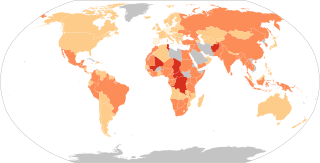Sexual assault is an act in which one intentionally sexually touches another person without that person's consent, or coerces or physically forces a person to engage in a sexual act against their will. It is a form of sexual violence that includes child sexual abuse, groping, rape, drug facilitated sexual assault, and the torture of the person in a sexual manner.
Psychological abuse, often called emotional abuse, is a form of abuse characterized by a person subjecting or exposing another person to a behavior that may result in psychological trauma, including anxiety, chronic depression, or post-traumatic stress disorder.
Sexual violence is any harmful or unwanted sexual act or attempt to obtain a sexual act by violence or coercion, act to traffic a person, regardless of the relationship to the victim. This includes forced engagement in sexual acts, attempted or completed acts and occurs without the consent of the victim. It occurs in times of peace and armed conflict situations, is widespread, and is considered to be one of the most traumatic, pervasive, and most common human rights violations.

Violence against women (VAW), also known as gender-based violence and sexual and gender-based violence (SGBV), are violent acts primarily or exclusively committed by men or boys against women or girls. Such violence is often considered a form of hate crime, committed against women or girls specifically because they are female, and can take many forms.
Gender is correlated with the prevalence of certain mental disorders, including depression, anxiety and somatic complaints. For example, women are more likely to be diagnosed with major depression, while men are more likely to be diagnosed with substance abuse and antisocial personality disorder. There are no marked gender differences in the diagnosis rates of disorders like schizophrenia and bipolar disorder. Men are at risk to suffer from post-traumatic stress disorder (PTSD) due to past violent experiences such as accidents, wars and witnessing death, and women are diagnosed with PTSD at higher rates due to experiences with sexual assault, rape and child sexual abuse. Nonbinary or genderqueer identification describes people who do not identify as either male or female. People who identify as nonbinary or gender queer show increased risk for depression, anxiety and post-traumatic stress disorder. People who identify as transgender demonstrate increased risk for depression, anxiety, and post-traumatic stress disorder.
Rape by gender classifies types of rape by the sex and/or gender of both the rapist and the victim. This scope includes both rape and sexual assault more generally. Most research indicates that rape affects women disproportionately, with the majority of people convicted being men; however, since the broadening of the definition of rape in 2012 by the FBI, more attention is being given to male rape, including females raping males.
Rape is a traumatic experience that affects the victim in a physical, psychological, and sociological way. Even though the effects and aftermath of rape differ among victims, individuals tend to suffer from similar issues found within these three categories. Long-term reactions may involve the development of coping mechanisms that will either benefit the victim, such as social support, or inhibit their recovery. Seeking support and professional resources may assist the victim in numerous ways.

Rape is a type of sexual assault involving sexual intercourse or other forms of sexual penetration carried out against a person without their consent. The act may be carried out by physical force, coercion, abuse of authority, or against a person who is incapable of giving valid consent, such as one who is unconscious, incapacitated, has an intellectual disability, or is below the legal age of consent. The term rape is sometimes used interchangeably with the term sexual assault.
Intimate partner violence (IPV) is domestic violence by a current or former spouse or partner in an intimate relationship against the other spouse or partner. IPV can take a number of forms, including physical, verbal, emotional, economic and sexual abuse. The World Health Organization (WHO) defines IPV as "any behavior within an intimate relationship that causes physical, psychological or sexual harm to those in the relationship, including acts of physical aggression, sexual coercion, psychological abuse and controlling behaviors." IPV is sometimes referred to simply as battery, or as spouse or partner abuse.
Intimate partner sexual violence (IPSV) deals with sexual violence within the context of domestic violence. Intimate partner sexual violence is defined by any unwanted sexual contact or activity by an intimate partner in order to control an individual through fear, threats, or violence. Women are the primary victims of this type of violence.
Sexual violence refers to a range of completed or attempted sexual acts in which the affected party does not or is unable to consent. Theories on the causes of sexual violence are numerous and have come out of many different disciplines, such as women's studies, public health, and criminal justice. Proposed causes include military conquest, socioeconomics, anger, power, sadism, traits, ethical standards, laws, and evolutionary pressures. Most of the research on the causes of sexual violence has focused on male offenders.

Surveys of victims of crime have been undertaken in many cities and countries, using a common methodology to aid comparability, and have generally included questions on sexual violence. The United Nations has conducted extensive surveys to determine the level of sexual violence in different societies. According to these studies, the percentage of women reporting having been a victim of sexual assault ranges from less than 2% in places such as La Paz, Bolivia (1.4%), Gaborone, Botswana (0.8%), Beijing, China (1.6%), and Manila, Philippines (0.3%), to 5% or more in Istanbul, Turkey (6.0%), Buenos Aires, Argentina (5.8%), Rio de Janeiro, Brazil (8.0%), and Bogota, Colombia (5.0%).

As sexual violence affects all parts of society, the responses that arise to combat it are comprehensive, taking place on the individual, administrative, legal, and social levels.

Domestic violence is violence or other abuse that occurs in a domestic setting, such as in a marriage or cohabitation. Domestic violence is often used as a synonym for intimate partner violence, which is committed by one of the people in an intimate relationship against the other person, and can take place in relationships or between former spouses or partners. In its broadest sense, domestic violence also involves violence against children, parents, or the elderly. It can assume multiple forms, including physical, verbal, emotional, economic, religious, reproductive, financial abuse, or sexual abuse. It can range from subtle, coercive forms to marital rape and other violent physical abuse, such as choking, beating, female genital mutilation, and acid throwing that may result in disfigurement or death, and includes the use of technology to harass, control, monitor, stalk or hack. Domestic murder includes stoning, bride burning, honor killing, and dowry death, which sometimes involves non-cohabitating family members. In 2015, the United Kingdom's Home Office widened the definition of domestic violence to include coercive control.
Pregnancy when coupled with domestic violence is a form of intimate partner violence (IPV) where health risks may be amplified. Abuse during pregnancy, whether physical, verbal or emotional, produces many adverse physical and psychological effects for both the mother and fetus. Domestic violence during pregnancy is categorized as abusive behavior towards a pregnant woman, where the pattern of abuse can often change in terms of severity and frequency of violence. Abuse may be a long-standing problem in a relationship that continues after a woman becomes pregnant or it may commence in pregnancy. Although female-to-male partner violence occurs in these settings, the overwhelming form of domestic violence is perpetrated by men against women. Pregnancy provides a unique opportunity for healthcare workers to screen women for domestic violence though a recent review found that the best way in which to do this is unclear. Reducing domestic violence in pregnancy should improve outcomes for mothers and babies though more good quality studies are needed to work out effective ways of screening pregnant women.

Papua New Guinea (PNG) is often labelled as potentially the worst place in the world for gender-based violence.

Domestic violence in same-sex relationships or intragender violence is a pattern of violence or abuse that occurs within same-sex relationships. Domestic violence is an issue that affects people of any sexuality, but there are issues that affect victims of same-sex domestic violence specifically. These issues include homophobia, internalized homophobia, HIV and AIDS stigma, STD risk and other health issues, lack of legal support, and the violence they face being considered less serious than heterosexual domestic violence. Moreover, the issue of domestic violence in same-sex relationships has not been studied as comprehensively as domestic violence in heterosexual relationships. However, there are legal changes being made to help victims of domestic violence in same-sex relationships, as well as organizations that cater specifically to victims of domestic violence in same-sex relationships.

Sexual assault of LGBT people, also known as sexual and gender minorities (SGM), is a form of violence that occurs within the LGBT community. While sexual assault and other forms of interpersonal violence can occur in all forms of relationships, it is found that sexual minorities experience it at rates that are equal to or higher than their heterosexual counterparts. There is a lack of research on this specific problem for the LGBT population as a whole, but there does exist a substantial amount of research on college LGBT students who have experienced sexual assault and sexual harassment.
Violence against women in the United States is the use of domestic abuse, murder, sex-trafficking, rape and assault against women in the United States. It has been recognized as a public health concern. Culture in the United States has led towards the trivialization of violence towards women, with media in the United States possibly contributing to making women-directed violence appear unimportant to the public.
Secondary victimisation refers to further victim-blaming from criminal justice authorities following a report of an original victimisation.







